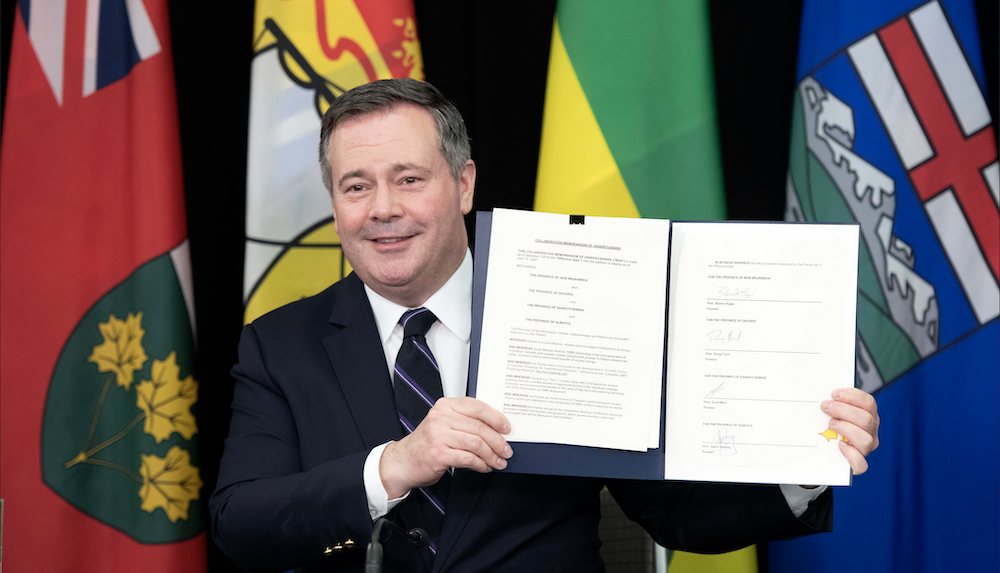By recycling some old news about their joint project to promote “small modular reactors” yesterday, Alberta, Saskatchewan, Ontario and New Brunswick have proved dubious ideas in Canada have a half-life worthy of a uranium isotope.
Well, maybe not quite that persistent. Some of those suckers can hang around for four and a half billion years. But the political equivalent, anyway.
The effort to sell us on the idea of small modular reactors (SMRs), the nuclear industry’s slightly sanitized term for small nuclear reactors, is an example of how bad ideas keep reappearing in this country like the proverbial bad penny — although a very large number of pennies are inevitably involved.
There’s always a certain amount of flimflammery in government news announcements, but yesterday’s contained more than usual. After a feasibility study, four Conservative provincial governments have now signed a memorandum of understanding to collaborate on the advancement of an unproven and expensive technology for which there is no market.
But since the Conservative premiers of Saskatchewan, Ontario and New Brunswick had already signed the speculative deal, the only thing actually approaching news yesterday was that Alberta signed up too. All four were on hand via teleconference link, with Ontario’s Doug Ford acting as master of ceremonies.
Unmentioned in the Alberta government’s verbose release was that the Kenney-come-lately province’s decision to join the deal last summer was likely the United Conservative Party government’s urgent need to change the channel on a huge political embarrassment — Education Minister Adriana LaGrange’s incoherent gong show of a curriculum-review news conference on August 7.
That in turn appeared to be an attempt by Premier Jason Kenney and his political strategists to distract Albertans from the fatal potential of the province’s half-baked plan to reopen Alberta’s schools in September without adequate measures in place to deal with the COVID-19 pandemic.
This can’t be said to have been a very successful sleight of hand. Months later, both issues are still plaguing the Alberta government. But as they say, in for a penny, in for a billion pounds!
Kenney’s enthusiastic description of this “exciting new technology that could be used in the future to significantly cut greenhouse gas emissions” was a chance to change the channel yet again. (Emphasis added.) This time, the Kenney government’s problems are the third wave of the pandemic that’s now hammering Alberta and the embarrassing rebellion by 18 backbench MLAs from the UCP’s own caucus who want to undermine the province’s effort to control the coronavirus. The curriculum, which has now been released to disastrous reviews, is not far from many Albertans’ minds either.
As for the yarn about little modular reactors producing clean energy — even “generating power for Canadian oilsands producers,” as Kenney hopefully put it — that’s almost certain to turn out to be a pipe dream.
As University of British Columbia theoretical physicist M.V. Ramana wrote last month in a paper entitled “Small Modular and Advanced Nuclear Reactors: A Reality Check,” “expectations that small modular or advanced nuclear reactors will rescue nuclear power are unlikely to be met.”
“Nuclear advocates seem to be clutching at straws by emphasizing these options,” he said.
Ramana argued that among the challenges facing the idea — which is not really a technology, as Premier Kenney claims, so much as a large number of competing concepts for smaller reactors that have never been built — are the facts they’re less economical to operate than large nuclear power plants, they aren’t likely to be able to compete even with renewable energy like wind and solar, they’re not necessarily safer than large reactors, some designs might even make safety challenges worse, and there’s no demand for the things.
In addition to the points raised by Ramana, small nuclear reactors are never going to make economic sense as long as natural gas is cheap and plentiful.
Of the dozens of SMR designs being touted throughout the world, only one doesn’t require enriched uranium — and Canada produces no enriched uranium. This means Energy Minister Sonya Savage’s claim last summer that “Alberta’s rich uranium deposits … could make us an attractive destination to develop and deploy SMRs” was flimflam too. Global uranium markets are saturated.
Moreover, attempts to build SMRs like Russia’s reactor on a barge, nicknamed “Floating Chernobyl” by critics, have experienced huge cost overruns, just like those common to large nuclear projects. “One study of construction cost overruns showed that 175 out of the 180 nuclear projects examined had final costs that exceeded the initial budget, on average by 117 per cent,” Ramana noted in his paper.
The problem of nuclear waste disposal remains unsolved as well.
Finally, even in the unlikely event SMRs become a marketable and affordable technology, most of the Canadian jobs created are likely to be in Ontario, where the manufacturing capacity and nuclear engineers are found.
Nice distraction, but this dog won’t hunt.
David Climenhaga, author of the Alberta Diary blog, is a journalist, author, journalism teacher, poet and trade union communicator who has worked in senior writing and editing positions at The Globe and Mail and the Calgary Herald.
Image credit: Chris Schwarz/Government of Alberta/Flickr




